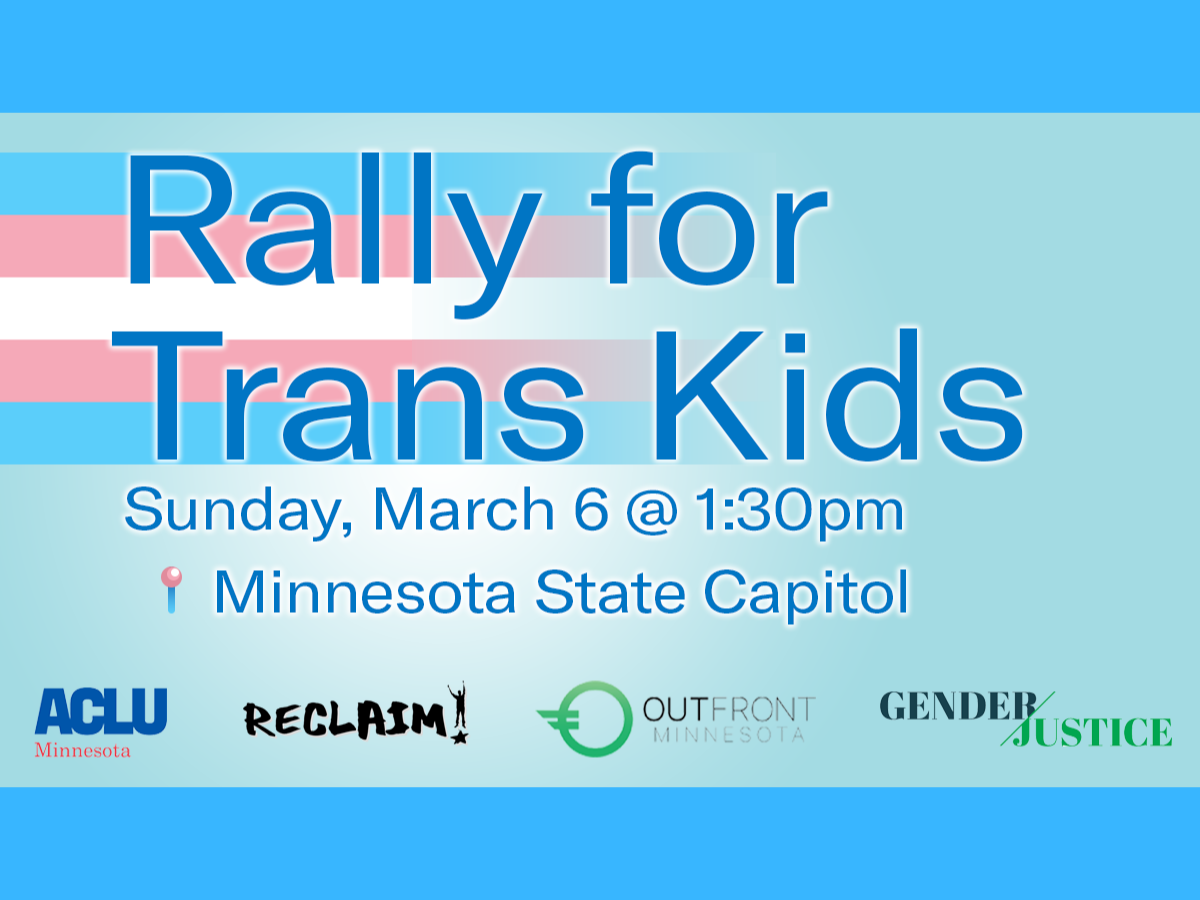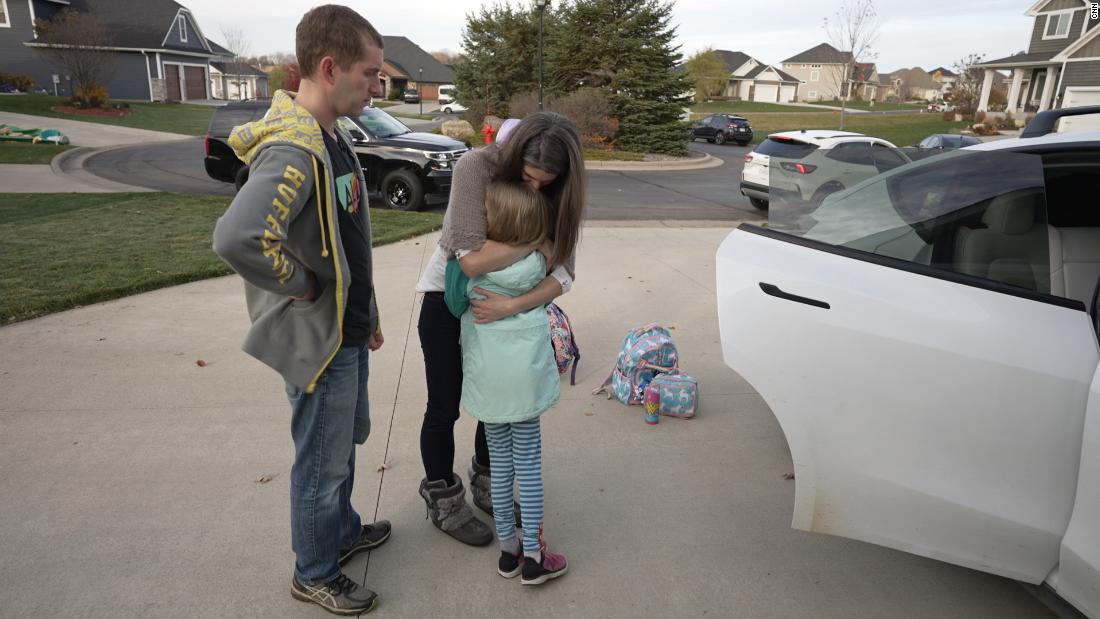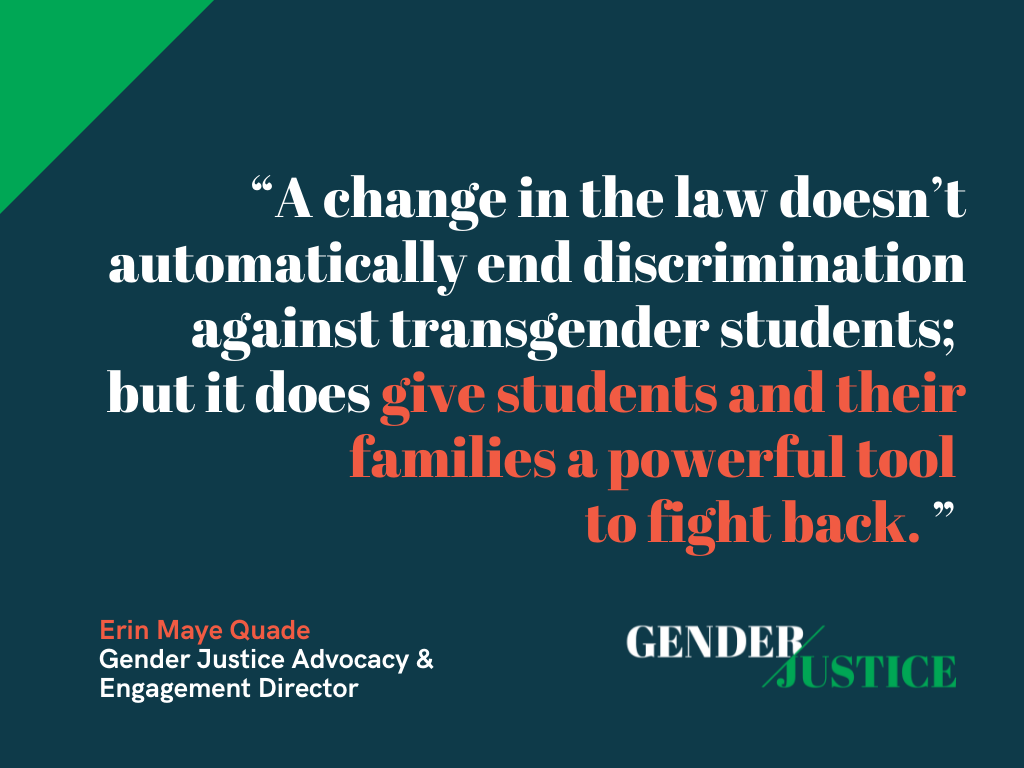
Transgender Students Head Back to School with New Protections
It’s not just a suggestion that schools respect the gender identities of trans students; it’s the law.
How We Make Change
What We Fight For
Where Barriers Occur
Resources & Advocacy Tools for Transgender Students and their Families
“New Year, New Law: Background” Handout
“Transgender Students: Know Your Rights” Handout
Advocacy Letter for Families of Transgender Students
Self-Advocacy Letter for Transgender Students
Right now, Minnesota students are returning to school from summer break following months of distance and remote learning. Some will be physically attending classes for the first time since transitioning at home, and they will return to school with new names, new pronouns, and new gender identities.
Not only have these students changed while they’ve been away from the physical classroom; schools’ legal obligations to respect and support them have also changed — and protections for transgender students are stronger than ever.
Thanks to recent legal victories, Minnesota law now unequivocally entitles transgender students to:
- Use the same restrooms, locker rooms, and other facilities as other students;
- Use the restrooms, locker rooms, and facilities that align with their gender identity;
- Participate in school-related activities, including on athletic teams, in a way that aligns with their gender identity;
- Be protected from bullying.
“The Minnesota Constitution, as well as the Minnesota Human Rights Act, protect transgender students at school. That’s now settled,” says Erin Maye Quade, Advocacy & Engagement Director at Gender Justice. “Unfortunately, a change in the law doesn’t automatically end discrimination against transgender students; but it does give students and their families a powerful tool to fight back. The goal of our campaign is to teach students and families how to use that tool.”
On this page, transgender students, their families, and Minnesota educators and school administrators can find helpful materials including information on recent legal victories, Know Your Rights handouts, and sample advocacy letters to help students and their families use the law to advocate for themselves if and when they do face discrimination.
Join our campaign to educate every transgender student in Minnesota, and their friends and families, about their new legal protections at school. Changes in the law don’t automatically end discrimination against trans, non-binary, and gender non-conforming students, but the new law does give students and their families a powerful tool to help them fight back. That’s why it’s critical that we connect students and their families with information and resources to help them advocate for themselves.
Spread the word on Twitter, Facebook, or LinkedIn. Or find us on Instagram (@genderjustice) and share our post!
News Updates
Erin Maye Quade, Advocacy Director
“The Minnesota Constitution, as well as the Minnesota Human Rights Act, protect transgender students at school. That’s now settled. Unfortunately, a change in the law doesn’t automatically end discrimination against transgender students; but it does give students and their families powerful tools to fight back. We're teaching students and families how to use those tools.”
"We're teaching students and families to use those tools."
New Year, New Law: Background
Download “New Year, New Law: Background” Handout
Our client Nick was singled out by his Minnesota high school and forced to use segregated changing facilities no other student was required to use, which led to bullying and threats.
We sued the Anoka-Hennepin school district because they treated Nick differently than other students – and failed to provide him with an equal and adequate education. We asserted that, in doing so, the district violated the Minnesota Human Rights Act and the Minnesota Constitution.
A State Court of Appeals agreed with us, and found that it violates both the Minnesota Human Rights Act and the Minnesota Constitution for school districts to segregate transgender students from their peers in locker room facilities.
This was a critical victory that expanded and cemented the rights of all transgender students in Minnesota schools.
This year alone, we’ve won more than half a million dollars in settlements for our transgender clients who experienced discrimination and bullying at schools. Our victories for trans students should put Minnesota schools on notice: It is illegal – and expensive – to discriminate against transgender students in our state.
Minnesota schools have a legal obligation to welcome these students back into respectful, informed, and trans-inclusive learning environments. As a result of our client Nick’s victory earlier this year, transgender students in Minnesota are legally entitled to:
- Use the same restrooms, locker rooms, and other facilities as other students.
- Use the restrooms, locker rooms, and other facilities that align with their gender identity.
- Participate authentically in all school-related activities.
- Participate on teams that align with their gender identity.
- Be protected from bullying.
Respecting transgender, non-binary, and gender non-conforming young people isn’t just a the law; It’s the right thing to do for Minnesota students. That’s because trans-inclusion is a life or death issue.
A recent survey conducted by the Trevor Project found that 52% of all transgender and non-binary young people in the U.S. seriously contemplated suicide in 2020. Being able to show up authentically, however, significantly mitigated trans and non-binary students’ risk of suicide and self-harm.
Transgender Students: Know Your Rights at School
Download “Know Your Rights” Handout
Transgender students in Minnesota are legally entitled to:
- Use the same restrooms and locker rooms as other students. Minnesota schools cannot force transgender students to use segregated bathroom and/or locker room facilities.
N.H. v. Anoka-Hennepin Sch. Dist. No. 11, 950 N.W.2d 553 (Minn. Ct. App. 2020); Minn. Stat. § 363A.13, subd. 1; Minn. Const. Art. I § 2. See also Title IX of the Education Amendments of 1972, 20 U.S.C. § 1681(a). See, e.g. Grimm v. Gloucester County School Board, 972 F.3d 586 (4th Cir. 2020); Whitaker v. Kenosha, 858 F.3d 1034 (7th Cir. 2017).
- Use the restrooms, locker rooms, and other facilities that align with their gender identity. Schools must allow transgender students to use facilities that align with their gender identities.
N.H. v. Anoka-Hennepin Sch. Dist. No. 11, 950 N.W.2d 553 (Minn. Ct. App. 2020); Minn. Stat. § 363A.13, subd. 1; Minn. Const. Art. I § 2. See also Title IX of the Education Amendments of 1972, 20 U.S.C. § 1681(a). See, e.g. Grimm v. Gloucester County School Board, 972 F.3d 586 (4th Cir. 2020); Whitaker v. Kenosha, 858 F.3d 1034 (7th Cir. 2017).
- Participate in all school-related activities. Schools should not treat students differently based on their gender, and students should be allowed to participate in school activities in a way that aligns with their identity.
The Minnesota Human Rights Act states that “[i]t is an unfair discriminatory practice to discriminate in any manner in the full utilization of or benefit from any educational institution, or the services rendered thereby.” Minn. Stat. § 363A.13 subd1.
- Participate on teams that align with their gender identity. The Minnesota State High School League allows all students, regardless of their gender, to participate in sports and play on teams that align with their gender identity.
MSHSL Official Handbook, 300.00 Bylaws: Administration of Student Eligibility, 2020-20201, 300.03. See also Minn. Stat. § 363A.13, subd. 1; Minn. Const. Art. I § 2; Title IX of the Education Amendments of 1972, 20 U.S.C. § 1681(a).
- Be protected from bullying. The Minnesota Human Rights Act protects all LGBTQ+ students from a hostile school environment.
Minn. Stat. § 363A.13, subd. 1. Additionally, the Safe and Supportive Minnesota Schools Act requires schools to adopt policies that prohibit harassment and bullying, including harassment and bullying based on sex, gender identity, gender expression and sexual orientation. Minn. Stat. § 121A.031 subd. 2(g).
The Minnesota Department of Education further recommends that:
- School faculty and staff should respect students’ names and pronouns. The Minnesota Department of Education Safe and Support Schools Toolkit states:
“Schools should not assume a student’s name, gender identity or pronoun. School officials should ask the student and use the requested name and pronouns. Students need not provide schools with legal documents to correct their first name or gender within their student records.
When students are referred to by the wrong pronoun by peers or school staff, students may feel intimidated, threatened, harassed or bullied. School staff can ensure a more respectful environment for all students when efforts are made to correct the misuse of pronouns, as well as names, in student records.”
Minnesota schools should be aware that pronoun usage impacts a significant number of students. In a 2020 study, The Trevor Project found that 1 in 4 LGBTQ youth use pronouns that fall outside of the binary construction of gender.
Self Advocacy Tools
Download the Advocacy Letter for Families of Transgender Students
Download the Self-Advocacy Letter for Transgender Students
Unfortunately, a change in the law doesn’t automatically end discrimination against transgender students; but it does give students and their families a powerful tool to fight back. We’ve created two template letters so that transgender students and/or their families can use the power of Minnesota law to advocate for themselves or their student.
You Can Help.
Donate
With your financial support, Gender Justice can continue to fight hard for our clients and push the laws forward in our legislature. Be there with us as we work to bring about big, systemic change. Give today.


